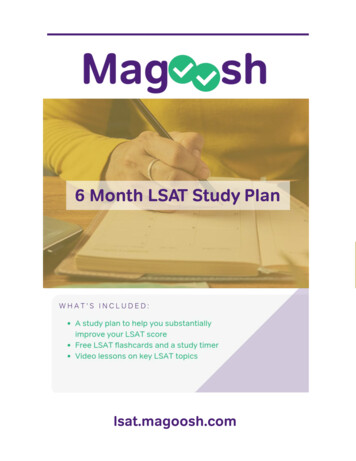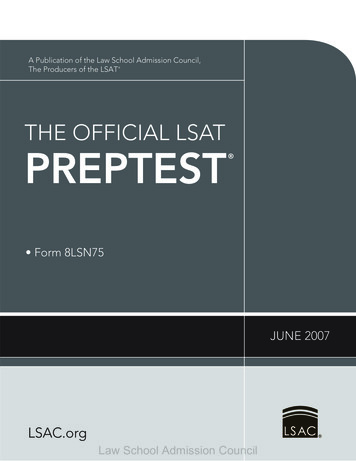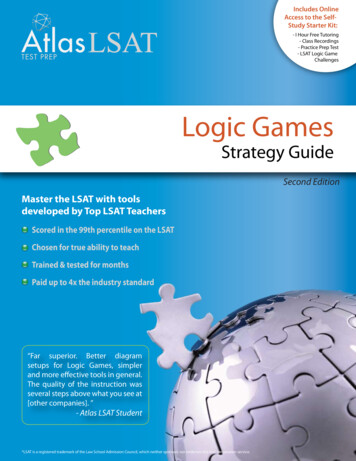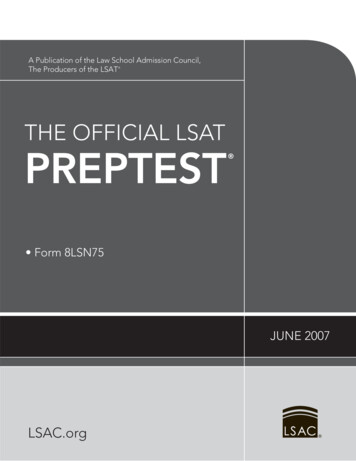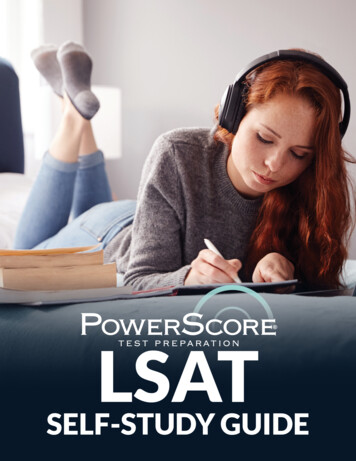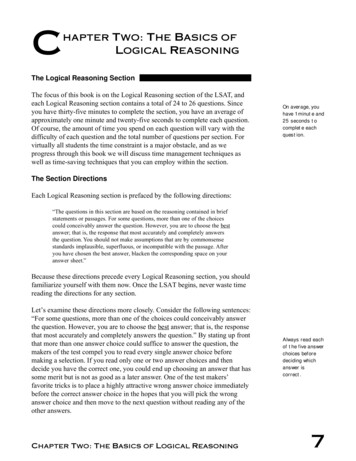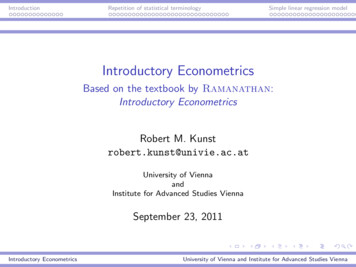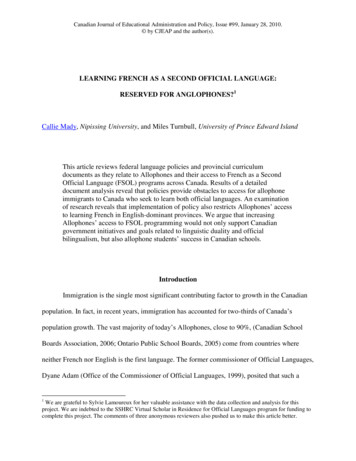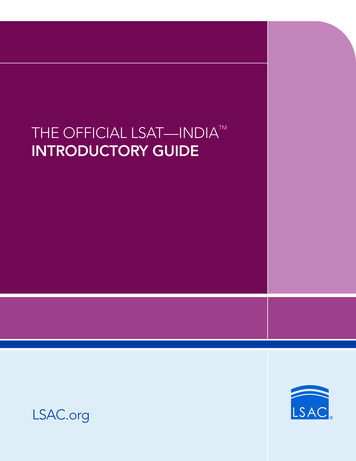
Transcription
THE OFFICIAL LSAT—INDIAINTRODUCTORY GUIDETMLSAC.org
The Law School Admission Council is a not-for-profit organization committed to promoting quality, access, and equity in law and educationworldwide by supporting individuals’ enrollment journeys and providing preeminent assessment, data, and technology services. Currently,221 law schools in the United States, Canada, and Australia are members of the Council and benefit from LSAC’s services. 2020 Law School Admission Council, Inc.LSAT, Law School Admission Test, The Official LSAT PrepTest, The Official LSAT SuperPrep, and LSAC are registered marks of the LawSchool Admission Council, Inc. Law School Forums, Credential Assembly Service, CAS, LLM Credential Assembly Service, and LLM CASare service marks of the Law School Admission Council, Inc. Law School Admission Test—India; Digital LSAT; LSAT Writing; 10 Actual,Official LSAT PrepTests; 10 More Actual, Official LSAT PrepTests; The Next 10 Actual, Official LSAT PrepTests; 10 Actual, Official LSATPrepTests 42–51; 10 New Actual, Official LSAT PrepTests with Comparative Reading; 10 Actual, Official LSAT PrepTests, Volume V; 10Actual, Official LSAT PrepTests, Volume VI; The Official LSAT SuperPrep II; LSAC Official Guide to ABA-Approved Law Schools; LSACOfficial Guide to LLM/Graduate Law Programs; The Official LSAT Handbook; ACES2; FlexApp; Candidate Referral Service; and Law SchoolAdmission Council are trademarks of the Law School Admission Council, Inc.All rights reserved. No part of this work, including information, data, or other portions of the work published in electronic form, maybe reproduced or transmitted in any form or by any means, electronic or mechanical, including photocopying, recording, or by anyinformation storage and retrieval system, without permission of the publisher. For information, write: Assessment Publications, Law SchoolAdmission Council, 662 Penn Street, PO Box 40, Newtown, PA 18940-0040.LSAC fees, policies, and procedures relating to, but not limited to, test registration, test administration, test score reporting, misconductand irregularities, Credential Assembly Service (CAS), and other matters may change without notice at any time. Up-to-date LSAC policiesand procedures are available at LSAC.org.
TABLE OF CONTENTS Introductory Guide to the LSAT—India . . . . . . . . . . . . . . . . . . . . . . . . . . . . . . . . . . . . . . . . . . . . . . . . . . . . . . . . . . . . . . . . . . . . . . . 1 Scoring . . . . . . . . . . . . . . . . . . . . . . . . . . . . . . . . . . . . . . . . . . . . . . . . . . . . . . . . . . . . . . . . . . . . . . . . . . . . . . . . . . . . . . . . . . . . . . 1 The Three LSAT—India Multiple-Choice Question Types . . . . . . . . . . . . . . . . . . . . . . . . . . . . . . . . . . . . . . . . . . . . . . . . . . . . .1 Analytical Reasoning Questions . . . . . . . . . . . . . . . . . . . . . . . . . . . . . . . . . . . . . . . . . . . . . . . . . . . . . . . . . . . . . . . . . . . . . . 1 Logical Reasoning Questions . . . . . . . . . . . . . . . . . . . . . . . . . . . . . . . . . . . . . . . . . . . . . . . . . . . . . . . . . . . . . . . . . . . . . . . . 2 Reading Comprehension Questions . . . . . . . . . . . . . . . . . . . . . . . . . . . . . . . . . . . . . . . . . . . . . . . . . . . . . . . . . . . . . . . . . . 3 Practising the LSAT—India . . . . . . . . . . . . . . . . . . . . . . . . . . . . . . . . . . . . . . . . . . . . . . . . . . . . . . . . . . . . . . . . . . . . . . . . . . . . . . 4 Sample Questions and Explanations . . . . . . . . . . . . . . . . . . . . . . . . . . . . . . . . . . . . . . . . . . . . . . . . . . . . . . . . . . . . . . . . . . . . . . . . . 5
INTRODUCTORY GUIDE TO THE LSAT—INDIAThe LSAT—India consists of five 35-minute sectionsof multiple-choice questions. Four of the five sectionscontribute to the test taker’s score. These sections includeone Reading Comprehension section, one AnalyticalReasoning section, and two Logical Reasoning sections.The unscored section, commonly referred to as the variablesection, typically is used to pretest new test questions. Theplacement of this section in the test will vary.The LSAT—India is designed to measure skills consideredessential for succeeding in law school: reading andcomprehending complex texts with accuracy and insight,organising and managing information and drawingreasonable inferences from it, thinking critically, andanalysing and evaluating the reasoning and arguments ofothers.The LSAT—India provides a standard measure of acquiredreading and verbal reasoning skills that law schools can useas one of several factors in assessing applicants.SCORINGYour LSAT—India score is based on the number of questionsyou answer correctly (the raw score). There is no negativemarking for incorrect answers, and all questions countequally. In other words, there is no penalty for guessing. Thescore scale for the test is 420 to 480.All test forms of the LSAT—India reported on the samescore scale are designed to measure the same abilities,but one test form may be slightly easier or more difficultthan another. The scores from different test forms aremade comparable through a statistical procedure knownas equating. As a result of equating, a given scaled scoreearned on different test forms reflects the same level ofability.THE THREE LSAT—INDIA MULTIPLE-CHOICEQUESTION TYPESThe multiple-choice questions on the LSAT—India reflect abroad range of academic disciplines and are not intended togive any advantage to candidates from particular academicbackgrounds. The LSAT—India does not include questionsrequiring the mastery of any specific discipline or set of facts.For example, it does not test your knowledge of history,political theory, mathematics, or even general knowledge.Rather, it is a test of important critical thinking skills acquiredover your educational lifetime.The following material presents a general discussion of thenature of each question type and some strategies that canbe used in answering them.Analytical Reasoning QuestionsAnalytical Reasoning questions are designed to assess theability to consider a group of facts and rules, and, giventhose facts and rules, determine what could or must betrue. The specific scenarios associated with these questionsare usually unrelated to law, since they are intended to beaccessible to a wide range of test takers. However, the skillstested do parallel those involved in determining what couldor must be the case given a set of regulations, the terms ofa contract, or the facts of a legal case in relation to the law.In Analytical Reasoning questions, you are asked to reasondeductively from a set of statements and rules or principlesthat describe relationships among persons, things, or events.Analytical Reasoning questions appear in sets, with eachset based on a single passage. The passage used for eachset of questions describes common ordering relationshipsor grouping relationships, or a combination of both types ofrelationships. Examples include scheduling employees forwork shifts, assigning instructors to class sections, orderingtasks according to priority, and distributing grants forprojects.Analytical Reasoning questions test a range of deductivereasoning skills. These include: Comprehending the basic structure of a set ofrelationships by determining a complete solutionto the problem posed (for example, an acceptableseating arrangement of all six diplomats around atable) Reasoning with conditional ‘if-then’ statements andrecognising logically equivalent formulations of suchstatements Inferring what could be true or must be true fromgiven facts and rules Inferring what could be true or must be true fromgiven facts and rules together with new information inthe form of an additional or substitute fact or rule Recognising when two statements are logicallyequivalent in context by identifying a condition or rulethat could replace one of the original conditions whilestill resulting in the same possible outcomesAnalytical Reasoning questions reflect the kinds ofdetailed analyses of relationships and sets of constraints thata law student must perform in legal problem solving. Forexample, an Analytical Reasoning passage might describesix diplomats being seated around a table, following certainrules of protocol as to who can sit where. You, the test taker,must answer questions about the logical implications of1
given and new information. For example, you may be askedwho can sit between diplomats X and Y, or who cannot sitnext to X if W sits next to Y. Similarly, if you were a studentin law school, you might be asked to analyse a scenarioinvolving a set of particular circumstances and a set ofgoverning rules in the form of constitutional provisions,statutes, administrative codes, or prior rulings that havebeen upheld. You might then be asked to determine thelegal options in the scenario: what is required given thescenario, what is permissible given the scenario, and whatis prohibited given the scenario. Or you might be askedto develop a ‘theory’ for the case: when faced with anincomplete set of facts about the case, you must fill in thepicture based on what is implied by the facts that are known.The problem could be elaborated by the addition of newinformation or hypotheticals. No formal training in logic isrequired to answer these questions correctly.Tips for Analytical ReasoningSome people may prefer to answer first those questionsabout a passage that seem less difficult and then thosethat seem more difficult. In general, it is best to finish onepassage before starting on another, because much timecan be lost in returning to a passage and re-establishingfamiliarity with its relationships. However, if you are havinggreat difficulty on one particular set of questions andare spending too much time on them, it may be to youradvantage to skip that set of questions and go on to thenext passage, returning to the problematic set of questionsafter you have finished the other questions in the section.Do not assume that because the conditions for a set ofquestions look long or complicated, the questions based onthose conditions will be especially difficult.Read the passage carefully. Careful reading andanalysis are necessary to determine the exact nature of therelationships involved in an Analytical Reasoning passage.Some relationships are fixed (for example, P and R mustalways work on the same project). Other relationships arevariable (for example, Q must be assigned to either team 1or team 3). Some relationships that are not stated explicitlyin the conditions are implied by and can be deduced fromthose that are stated (for example, if one condition aboutpaintings in a display specifies that Painting K must be tothe left of Painting Y, and another specifies that Painting Wmust be to the left of Painting K, then it can be deduced thatPainting W must be to the left of Painting Y).In reading the conditions, do not introduce unwarrantedassumptions. For instance, in a set of questions establishingrelationships of height and weight among the members of ateam, do not assume that a person who is taller than anotherperson must weigh more than that person. As anotherexample, suppose a set involves ordering and a questionin the set asks what must be true if both X and Y must beearlier than Z; in this case, do not assume that X must beearlier than Y merely because X is mentioned before Y. All2the information needed to answer each question is providedin the passage and the question itself.The conditions are designed to be as clear as possible.Do not interpret the conditions as if they were intendedto trick you. For example, if a question asks how manypeople could be eligible to serve on a committee, consideronly those people named in the passage unless directedotherwise. When in doubt, read the conditions in their mostobvious sense. Remember, however, that the language in theconditions is intended to be read for precise meaning. It isessential to pay particular attention to words that describe orlimit relationships, such as ‘only’, ‘exactly’, ‘never’, ‘always’,‘must be’, ‘cannot be’, and the like.The result of this careful reading will be a clear pictureof the structure of the relationships involved, including thekinds of relationships permitted, the participants in therelationships, and the range of possible actions or attributesfor these participants.Keep in mind question independence. Each question shouldbe considered separately from the other questions in its set. Noinformation, except what is given in the original conditions, shouldbe carried over from one question to another.In some cases, a question will simply ask for conclusionsto be drawn from the conditions as originally given. Somequestions may, however, add information to the originalconditions or temporarily suspend or replace one of theoriginal conditions for the purpose of that question only. Forexample, if Question 1 adds the supposition ‘if P is sitting attable 2.’, this supposition should NOT be carried over toany other question in the set.Logical Reasoning QuestionsArguments are a fundamental part of the law, and analysingarguments is a key element of legal analysis. Training in thelaw builds on a foundation of basic reasoning skills. Lawstudents must draw on the skills of analysing, evaluating,constructing, and refuting arguments. They need to beable to identify what information is relevant to an issue orargument and what impact further evidence might have.They need to be able to reconcile opposing positions anduse arguments to persuade others.Logical Reasoning questions evaluate the ability toanalyse, critically evaluate, and complete arguments asthey occur in ordinary language. The questions are basedon short arguments drawn from a wide variety of sources,including newspapers, general interest magazines, scholarlypublications, advertisements, and informal discourse. Thesearguments mirror legal reasoning in the types of argumentspresented and in their complexity, although few of thearguments actually have law as a subject matter.Each Logical Reasoning question requires you to read andcomprehend a short passage, then answer one question (or,rarely, two questions) about it. The questions are designedto assess a wide range of skills involved in thinking critically,with an emphasis on skills that are central to legal reasoning.
These skills include: Recognising the parts of an argument and theirrelationships Recognising similarities and differences betweenpatterns of reasoning Drawing well-supported conclusions Reasoning by analogy Recognising misunderstandings or points ofdisagreement Determining how additional evidence affects anargument Detecting assumptions made by particular arguments Identifying and applying principles or rules Identifying flaws in arguments Identifying explanationsThe questions do not presuppose specialised knowledgeof logical terminology. For example, you will not beexpected to know the meaning of specialised terms suchas ‘ad hominem’ or ‘syllogism’. On the other hand, youwill be expected to understand and critique the reasoningcontained in arguments. This requires that you possess anunderstanding of widely used concepts such as argument,premise, assumption, and conclusion.Tips for Logical ReasoningRead each question carefully. Make sure that you understandthe meaning of each part of the question. Make sure thatyou understand the meaning of each answer choice andthe ways in which it may or may not relate to the questionposed.Do not pick a response simply because it is a truestatement. Although true, it may not answer the questionposed.Answer each question on the basis of the information thatis given, even if you do not agree with it. Work within thecontext provided by the passage. LSAT—India questions donot involve any tricks or hidden meanings.Reading Comprehension QuestionsBoth law school and the practise of law involve extensivereading of highly varied, dense, argumentative, andexpository texts (for example, cases, codes, contracts, briefs,decisions, and evidence). This reading must be exacting,distinguishing precisely what is said from what is not said.It involves comparison, analysis, synthesis, and application(for example, of principles and rules). It involves drawingappropriate inferences and applying ideas and arguments tonew contexts. Law school reading also requires the ability tograsp unfamiliar subject matter and the ability to penetratedifficult and challenging material.The purpose of LSAT—India Reading Comprehensionquestions is to measure the ability to read, withunderstanding and insight, examples of lengthy andcomplex materials similar to those commonly encounteredin law school. The Reading Comprehension section containsfour sets of reading questions, each set consisting of aselection of reading material followed by five to eightquestions. The reading selection in three of the four setsconsists of a single reading passage; the other set generallycontains two related shorter passages. Sets with twopassages are a variant of Reading Comprehension calledComparative Reading.Comparative Reading questions concern the relationshipsbetween the two passages, such as those of generalisation/instance, principle/application, or point/counterpoint.Law school work often requires reading two or more textsin conjunction with each other and understanding theirrelationships. For example, a law student may read a trialcourt decision together with an appellate court decision thatoverturns it, or identify the fact pattern from a hypotheticalsuit together with the potentially controlling case law.Reading selections for Reading Comprehension questionsare drawn from a wide range of subjects in the humanities,social sciences, biological and physical sciences fields, andareas related to the law. Generally, the selections are denselywritten, use high-level vocabulary, and contain sophisticatedargument or complex rhetorical structure (for example,multiple points of view). Reading Comprehension questionsrequire you to read carefully and accurately, to determinethe relationships among the various parts of the readingselection, and to draw reasonable inferences from thematerial in the selection. The questions may ask about thefollowing characteristics of a passage or pair of passages: The main idea or primary purpose Information that is explicitly stated Information or ideas that can be inferred The meaning or purpose of words or phrases as usedin context The organisation or structure The application of information in the selection to anew context Principles that function in the selection Analogies to claims or arguments in the selection An author’s attitude as revealed in the tone of apassage or the language used The impact of new information on claims or argumentsin the selection3
Tips for Reading ComprehensionSince reading selections are drawn from many differentdisciplines and sources, you should not be discouraged ifyou encounter material with which you are not familiar. It isimportant to remember that questions are to be answeredexclusively on the basis of the information provided in theselection. There is no particular knowledge that you areexpected to bring to the test, and you should not makeinferences based on any prior knowledge of a subject thatyou may have. You may, however, wish to defer working on aset of questions that seems particularly difficult or unfamiliaruntil after you have dealt with sets you find easier.One question that often arises in connection with ReadingComprehension has to do with the most effective andefficient order in which to read the selections and questions.Possible approaches include: reading the selection very closely and then answeringthe questions; reading the questions first, reading the selectionclosely, and then returning to the questions; or skimming the selection and questions very quickly,then rereading the selection closely and answering thequestions.Test takers are different, and the best strategy for onemight not be the best strategy for another. In preparing forthe test, therefore, you might want to experiment with thedifferent strategies and decide what works most effectivelyfor you.Remember that your strategy must be effective undertimed conditions. For this reason, the first strategy—reading the selection very closely and then answering thequestions—may be the most effective for you. Nonetheless,if you believe that one of the other strategies might bemore effective for you, you should try it out and assess yourperformance using it.Reading the selection. Whatever strategy you choose,you should give the passage or pair of passages at leastone careful reading before answering the questions. Tryto distinguish main ideas from supporting ideas, andopinions or attitudes from factual, objective information.Note transitions from one idea to the next and identifythe relationships among the different ideas or parts of apassage, or between the two passages in ComparativeReading sets. Consider how and why an author makes pointsand draws conclusions. Be sensitive to implications of whatthe passages say.You may find it helpful to mark key parts of passages.For example, you might underline main ideas or importantarguments, and you might note transitional words—‘although’, ‘nevertheless’, ‘correspondingly’, and the like—that will help you map the structure of a passage. Also, youmight note descriptive words that will help you identify anauthor’s attitude towards a particular idea or person.4Answering the Questions Always read all the answer choices before selecting the bestanswer. The best answer choice is the one that most accuratelyand completely answers the question being posed. Respond to the specific question being asked. Do not pickan answer choice simply because it is a true statement. Forexample, picking a true statement might yield an incorrectanswer to a question in which you are asked to identifyan author’s position on an issue, since you are not beingasked to evaluate the truth of the author’s position butonly to correctly identify what that position is. Answer the questions only on the basis of the informationprovided in the selection. Your own views, interpretations,or opinions, and those you have heard from others, maysometimes conflict with those expressed in a readingselection; however, you are expected to work within thecontext provided by the reading selection. You should notexpect to agree with everything you encounter in ReadingComprehension passages.PRACTISING THE LSAT—INDIAOne important way to prepare for the LSAT—India is tosimulate the day of the test by taking practise tests underactual time constraints. Taking practise tests under timedconditions helps you to estimate the amount of time youcan afford to spend on each question in a section and todetermine the question types on which you may needadditional practise.During the test, you may work only on the section designatedby the invigilator. You cannot devote extra time to a difficultsection and make up that time on a section you find easier. Inpacing yourself, and checking your answers, you should think ofeach section of the test as a separate minitest.Be sure that you answer every question on the test. Whenyou do not know the correct answer to a question, firsteliminate the responses that you know are incorrect, then makeyour best guess among the remaining choices. Do not be afraidto guess, as there is no penalty for incorrect answers.When you take a practise test, abide by all therequirements specified in the directions and keep strictlywithin the specified time limits. Work without a rest period.When taken under conditions as much like actual testingconditions as possible, a practise test provides very usefulpreparation for taking the LSAT—India.Sample Questions with ExplanationsThe remainder of this Guide contains a few examples ofeach question type along with complete explanations forevery correct and incorrect answer. Study these examplesand explanations to get an idea about the nature of thedifferent types of questions on the LSAT—India.
SAMPLE QUESTIONS AND EXPLANATIONS Analytical Reasoning. . . . . . . . . . . . . . . . . . . . . . . . . . 6 Logical Reasoning . . . . . . . . . . . . . . . . . . . . . . . . . . . . 9 Reading Comprehension . . . . . . . . . . . . . . . . . . . . . 145
ANALYTICAL REASONINGExactly eight boats—Jewel, Kashmir, Neptune, Ojibwa,Pacific, Spain, Tornado, and Valhalla—arrived at a dock.No boat arrived at the same time as any other boat. Theboats arrived in an order consistent with the followingconditions:Tornado arrived before Spain but after Jewel.Neptune arrived before Tornado.Kashmir arrived after Jewel but before Spain.Spain arrived before Ojibwa.1.If Neptune arrived after Kashmir, which one of thefollowing must be false?(A)(B)(C)(D)(E)Jewel was the second of the boats to arrive.Kashmir was the fifth of the boats to arrive.Neptune was the third of the boats to arrive.Ojibwa was the sixth of the boats to arrive.Spain was the seventh of the boats to arrive.Which one of the following must be true?2.(A)(B)(C)(D)(E)3.(B)(C)(D)(E)one, fivetwo, fivethree, fiveone, sixtwo, sixANALYTICAL REASONING EXPLANATIONSQuestions 1–6What the setup tells you: This group of questions concernsthe order in which eight boats arrived, one at a time, at adock. The conditions tell you when certain boats arrivedrelative to other boats. Putting the conditions together, youget the following hmirOne of the most important things to note is that two ofthe boats—Pacific and Valhalla—are completely unrestrictedby the conditions. That means that they could have arrivedanywhere in the sequence.(A)Overview: This question asks you to find the one answerchoice that cannot be true if Neptune arrived after Kashmir.So the incorrect answer choices will all be things that can betrue under those conditions. From the setup, you know thatNeptune had to arrive before Tornado, and Kashmir had toarrive after Jewel. So if Neptune arrived after Kashmir, therelative order in which six of the boats had to arrive is(A)(B)(C)(D)(E)noneonetwothreefourJewel was the third to arrive.Jewel was the first to arrive.Kashmir was the third to arrive.Pacific was the third to arrive.Tornado was the third to arrive.If Valhalla arrived before Neptune but after Pacific,which one of the following could be true?(A)(B)(C)(D)(E)6(A)Question 1Of the eight boats, if Valhalla was the second to arrive,then which one of the following CANNOT be true?5.Of the boats, what are, respectively, the minimumnumber and the maximum number that could havearrived before Kashmir?Of the eight boats, what is the maximum number thatcould have arrived before Jewel?(B)(C)(D)(E)4.At least two of the boats arrived beforeNeptune.At least five of the boats arrived before Pacific.At least four of the boats arrived before Spain.At least three of the boats arrived beforeTornado.At least two of the boats arrived before Valhalla.6.Tornado arrived before Valhalla.Kashmir arrived before Pacific.Ojibwa was not the last of the boats to arrive.Spain arrived before Valhalla.Spain was not the seventh of the boats to etting aside Pacific and Valhalla for the moment, theboats would have the positions shown above.What effect would taking account of Pacific and Valhallahave? Suppose they both arrived after Ojibwa. The positionsof the other six boats would remain exactly the same. Now, ifPacific and Valhalla both arrived before Jewel—which wouldput them in positions 1 and 2—the other six boats would beshifted down exactly two places (Jewel would be in position3, Kashmir in position 4, and so on). And in fact, no matterwhere either Pacific or Valhalla is in the sequence, none ofthe other six boats will shift more than two places down. Forexample, Jewel could have arrived either first, second, orthird; Neptune could have arrived either third, fourth, or fifth;and so on.
With this in mind, you can turn to the individual answerchoices and directly determine which ones can and cannotbe true.B, EThe Correct Answer:BAs discussed above, Kashmir could have arrivedsecond, third, or fourth. Since (B) has Kashmir arrivingfifth, you know that (B) can’t be true.The Incorrect Answer Choices:AAs discussed above, Jewel could have arrived first,second, or third. So (A) can be true.CAs discussed above, Neptune could have arrivedthird, fourth, or fifth. So (C) can be true.DAs discussed above, Ojibwa could have arrived sixth,seventh, or eighth. So (D) can be true.EAs discussed above, Spain could have arrived fifth,sixth, or seventh. So (E) can be true.Question 3Overview: Essentially what this question is asking is thefollowing: If as many boats as possible arrived before Jewel,how many boats would that be?The Correct Answer:DQuestion 2Overview: In this question, you’re asked what must be trueon the basis of the setup alone. You know from ‘What thesetup tells you’ that Pacific and Valhalla could have arrivedanywhere in the sequence. Thus, there is nothing that mustbe true of either one. So you can immediately rule out (B)and (E). That leaves only three answer choices to check.Since you know that Spain must have arrived relatively late inthe sequence, (C) is a good answer choice to check first.The Correct Answer:CFrom what the setup conditions tell you, you knowthat Jewel, Neptune, Kashmir, and Tornado all arrivedbefore Spain did. So whether or not Pacific or Valhallaalso arrived before Spain, you know that there are atleast four boats that must have arrived before Spain.You are now done. There’s no need to check the otheranswer choices.(B) describes a restriction involving Pacific, and (E)describes a restriction involving Valhalla. However,these boats are not restricted by the conditions. Sogiven just the
The Law School Admission Council is a not-for-profit organization committed to promoting quality, access, and equity in law and education worldwide by supporting individuals’ enrollment journeys and provid
